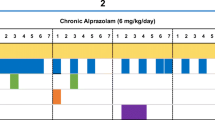Abstract
The lowest dose of alprazolam, diazepam, flunitrazepam and oxazepam consistently to induce loss of righting reflex in squirrel monkeys or vehicle was orally administered to monkeys on 18 consecutive days: 2 mg/kg alprazolam (n=4), 30 mg/kg diazepam (n=4), 1 mg/kg flunitrazepam (n=4), 280 mg/kg oxazepam (n=5), or vehicle (n=4). Tolerance developed rapidly for loss of righting reflex, more slowly for sleep and only minimally for muscle relaxation observed during the period immediately following daily oral administration. Injection of the specific benzodiazepine receptor antagonist flumazenil (10 mg/kg IV) 5 h after the ninth daily oral treatment produced signs of precipitated withdrawal (tremor, vomiting and/or convulsions) in one alprazolam-, four diazepam-, one flunitrazepam- and four oxazepam-treated monkeys, but not in the vehicle-treated monkeys. Physiological saline injected intravenously several days later under these same experimental conditions failed to provoke a precipitated withdrawal reaction. When flumazenil-induced precipitated withdrawal was again evaluated after the 18th daily oral treatment, withdrawal signs were observed in all alprazolam- and all diazepam-treated monkeys, as well as in three flunitrazepam- and three oxazepam-treated monkeys, but not in the vehicle-treated monkeys (convulsions were observed in one alprazolam-, two diazepam-, one flunitrazepam- and two oxazepam-treated monkeys). No signs of spontaneous withdrawal were observed in any of the monkeys during a subsequent 3-week drug-free period. Thus, repeated administration of approximately equieffective doses of these four benzodiazepines resulted in a similar development of tolerance and physical dependence (indicated by the occurrence of a precipitated withdrawal reaction).
Similar content being viewed by others
References
Baldwin HA, File SE (1988) Reversal of increased anxiety during benzodiazepine withdrawal: evidence for an anxiogenic endogenous ligand for the benzodiazepine receptor. Brain Res Bull 20:603–606
Baldwin HA, File SE (1989) Flumazenil prevents the development of chlordiazepoxide withdrawal in rats tested in the social interaction test of anxiety. Psychopharmacology 97:424–426
Baldwin HA, Hitchcott PK, File SE (1990) The use of flumazenil in prevention of diazepam dependence in the rat. Hum Psychopharmacol 5:57–61
Bernik MA, Gorenstein C, Gentil V (1991) Flumazenil-precipitated withdrawal symptoms in chronic users of therapeutic doses of diazepam. J Psychopharmacol 5:215–219
Cittadini A, Lader M (1991) Lack of effect of a small dose of flumazenil in reversing short-term tolerance to benzodiazepines in normal subjects. J Psychopharmacol 5:220–227
Cumin R, Bonetti EP, Scherschlicht R, Haefely WE (1982) Use of the specific benzodiazepine antagonist, Ro 15-1788, in studies of physiological dependence of benzodiazepines. Experientia 38:833–834
Gallager DW, Heninger K, Heninger G (1986) Periodic benzodiazepine antagonist administration prevents benzodiazepine withdrawal symptoms in primates. Eur J Pharmacol 132:31–38
Gallager DW, Heninger C, Wilson MA (1989) Chronic benzodiazepine agonist exposure and its consequences for GABA-benzodiazepine interactions. In: EA Barnard, E Costa (eds) Allosteric modulation of amino acid receptors: therapeutic implications. Raven Press, New York, pp 91–108
Gonsalves SF, Gallager DW (1988) Persistent reversal of tolerance to anticonvulsant effects and GABAergic subsensitivity by a single exposure to benzodiazepine antagonist during chronic benzodiazepine administration. J Pharmacol Exp Ther 244:79–83
Grant SJ, Galloway MP, Mayor R, Fenerty JP, Finkelstein MF, Roth RH, Redmond DE (1985) Precipitated diazepam withdrawal elevates noradrenergic metabolism in primate brain. Eur J Pharmacol 107:127–132
Haefely W (1984) Pharmacological profile of two benzodiazepine partial agonists: Ro 16-6028 and Ro 17-1812. Clin Neuropharmacol 7 [Suppl. 1]:670–671
Lader M, Morton S (1991) Benzodiazepine problems. Br J Addict 86:823–828
Lamb RJ, Griffiths RR (1985) Effects of repeated Ro 15-1788 administration in benzodiazepine-dependent baboons. Eur J Pharmacol 110:257–261
Löscher W, Rundfeldt C (1989) Intermittent flumazenil and benzodiazepine tolerance: Discouraging findings in rats. Lancet i:1386
Lukas SE, Griffiths RR (1982) Precipitated withdrawal by a benzodiazepine receptor antagonist (Ro 15-1788) after 7 days of diazepam. Science 217:1161–1163
Lukas SE, Griffiths RR (1984) Precipitated withdrawal in baboons: Effects of dose and duration of diazepam exposure. Eur J Pharmacol 100:163–171
Martin JR, Pieri L, Bonetti EP, Schaffner R, Burkard WP, Cumin R, Haefely WE (1988) Ro 16-6028: a novel anxiolytic acting as a partial agonist at the benzodiazepine receptor. Pharmacopsychiatry 21:360–362
Martin JR, Kuwahara A, Horrii I, Moreau J-L, Jenck F, Sepinwall J, Haefely WE (1990) Evidence that the benzodiazepine receptor partial agonist Ro 16-6028 has minimal abuse and physical dependence liability. Soc Neurosci Abstr 16:1104
McNicholas LF, Martin WR (1982) The effect of benzodiazepine antagonist, Ro 15-1788, in diazepam dependent rat. Life Sci 31:731–737
Nutt DJ, Costello MJ (1988) Rapid induction of lorazepam dependence and reversal with flumazenil. Life Sci 43:1045–1053
Ongini E, Marzanatti M, Bamonte F, Monopoli A, Guzzon V (1985) Aβ-carboline antagonizes benzodiazepine actions but does not precipitate the abstinence syndrome in cats. Psychopharmacology 86:132–136
Sannerud CA, Cook JM, Griffiths RR (1989) Behavioral differentiation of benzodiazepine ligands after repeated administration in baboons. Eur J Pharmacol 167:333–343
Savic I, Widen L, Stone-Elander S (1991) Feasibility of reversing benzodiazepine tolerance with flumazenil. Lancet 337:133–137
Schauben JL (1992) Flumazenil and precipitated benzodiazepine withdrawal reaction. Curr Ther Res 52:152–159
Sloan JW, Martin WR, Wala EP (1991) A comparison of the physical dependence inducing properties of flunitrazepam and diazepam. Pharmacol Biochem Behav 39:395–405
Woods JH, Katz JL, Winger G (1992) Benzodiazepines: use, abuse, and consequences. Pharmacol Rev 44:151–347
Author information
Authors and Affiliations
Rights and permissions
About this article
Cite this article
Martin, J.R., Moreau, JL. & Jenck, F. Precipitated withdrawal in squirrel monkeys after repeated daily oral administration of alprazolam, diazepam, flunitrazepam or oxazepam. Psychopharmacology 118, 273–279 (1995). https://doi.org/10.1007/BF02245955
Received:
Revised:
Issue Date:
DOI: https://doi.org/10.1007/BF02245955



